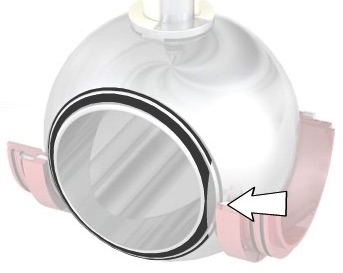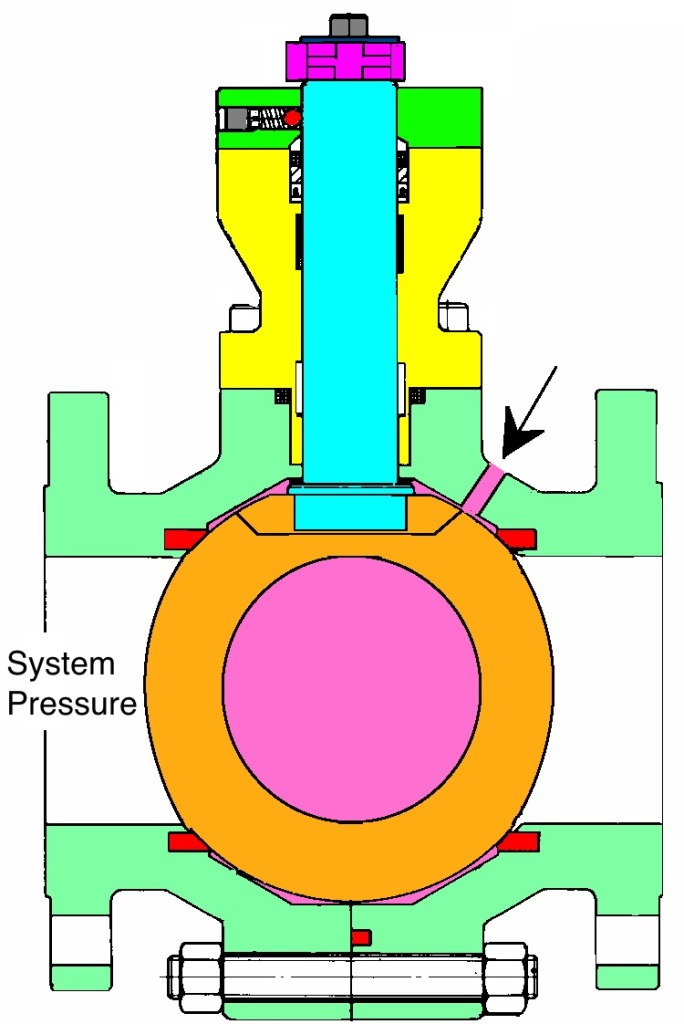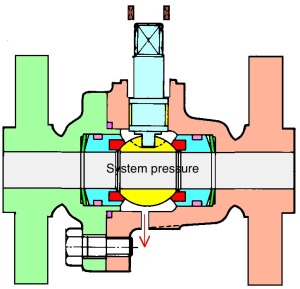Floating ball valves are more than just floating ball valves Part 3
As explained in parts 1 and 2 of this article series, the auxiliary valve fitted into the body of the valve can be very important if we are to create double sealing for a particular work situation, or if we want to test the seats/ball for tightness. The auxiliary valve can also come in handy when repairing a leaking valve. One possible cause of leakage may be represented by the deposits that are formed behind the ball seat when the valve is in the open position. When the valve is closed, the seats will be positioned on top of the deposits, as illustrated in fig. 9, thus causing leaks when the valve is in the closed position.
One solution to this problem is to clean the sealing areas of the ball. This may be done by moving the ball forwards and backwards to about 10-15% in the closed position. If the body of the valve is equipped with an auxiliary valve, the deposits may also be removed by pouring valve cleaner or kerosene into the cavity. Valve cleaner or kerosene can loosen the deposits so that the sealing areas are easier to clean when the ball is operated.
Also, it is not unusual for scratches on the sealing areas of the seats and the ball to result in leakage. Such leakage cannot be stopped by means of washing. Moreover, cleaning the sealing areas of the ball can lead to uncovering scratches in the ball and seats, which again results in valve leakage. If there is a leak caused by scratches in a ball valve with floating seats, a sealant may be used in some cases to secure a tight valve, as illustrated in fig. 10.
Since the main seal of a floating ball valve is on the downstream seat, a sealant injected into the cavity of the valve will be pressed against the downstream seal by the system pressure. To make the valve seal sealant has to be is thick enough, so it does not get pushed past the seal and beyond. However, you should bear in mind that the area around the ball and in the ball bore is also filled with sealant, as illustrated in fig. 10. The next time the valve is opened, all the sealant in the ball bore, as well as some of the sealant in the valve cavity will flow downwards in the system. The drawback in this case is that the sealant can cause damage to equipment downstream of the valve.
The last alternative use of an auxiliary valve to be covered in this article, relates to the case of a spindle leakage in a floating ball valve with floating seats. It doesn’t matter if they are self-relief (SR) or double piston (DP) seats, as long as they are floating seats with radial seals.
Illustrated in fig. 11 the starting point is with the valve in its open position; in this case the ball must not be provided with a balance hole. If the ball is provided with a balance hole, the valve must be in the closed position. The system pressure should be known, for instance 12 bars. Make sure that the valve cavity has been depressurized through the auxiliary valve and the seats have been tested by leaving the valve for 15 minutes without recording any leakage through the auxiliary valve at the bottom of the valve body. Then the lever, the press gland and the packing should be removed, as illustrated in fig. 12. A new spindle packing should be fitted in, followed by the press gland and the lever. The spindle packing should be tightened according to the supplier’s instructions. The cavity should then be slowly pressurized so as to test the new spindle packing up to its pressure limit.
This procedure can be carried out with the valve in full production. However, the prerequisite is to be able to replace the spindle packing with the spindle remaining in place in the valve body. You should NOT attempt to do this with spindles where you have to take off the spindle in order to replace the spindle seal. In this case, the system MUST be depressurized first.
As I have tried to demonstrate in this series of three articles, there should be greater awareness in the selection process of a floating ball valve. Should we use a valve with fixed seats or floating seats? Should the seats be floating SR seats or DP seats? Should the ball be provided with a balance hole or not? Should the valve body be equipped with an auxiliary valve and should we use a spindle seal, which can be replaced while under pressure? It has to be agreed, however, that a floating ball valve is more than just a floating ball valve, as it offers many alternative solutions and possible uses.
The End
Do you want to download this article as a PDF?
Click here to download




